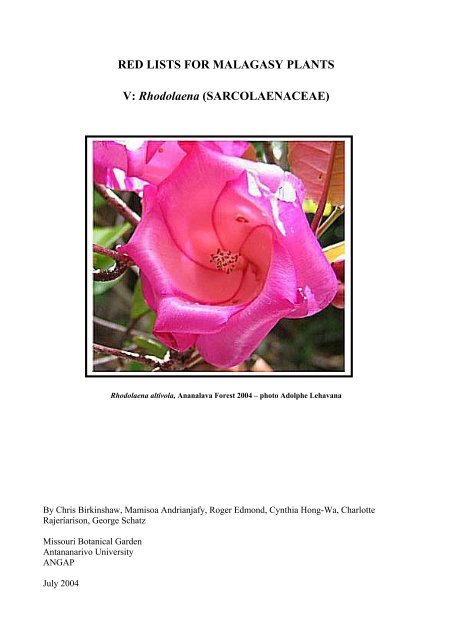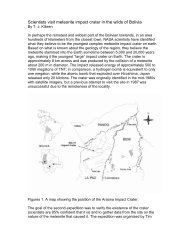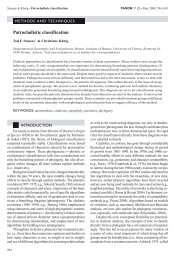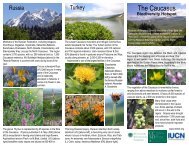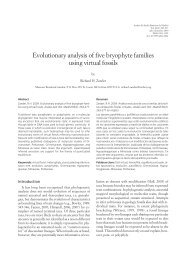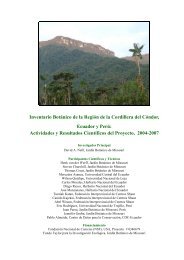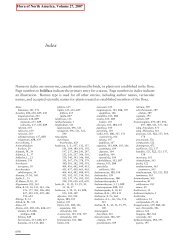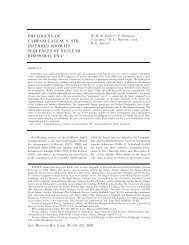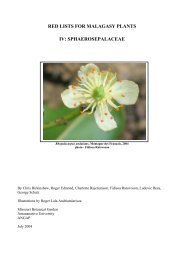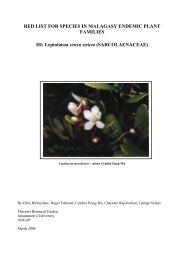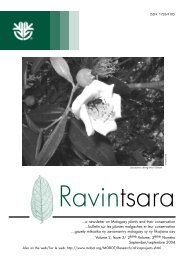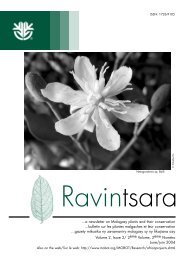red lists for malagasy plants - Missouri Botanical Garden
red lists for malagasy plants - Missouri Botanical Garden
red lists for malagasy plants - Missouri Botanical Garden
Create successful ePaper yourself
Turn your PDF publications into a flip-book with our unique Google optimized e-Paper software.
RED LISTS FOR MALAGASY PLANTS<br />
V: Rhodolaena (SARCOLAENACEAE)<br />
Rhodolaena altivola, Ananalava Forest 2004 – photo Adolphe Lehavana<br />
By Chris Birkinshaw, Mamisoa Andrianjafy, Roger Edmond, Cynthia Hong-Wa, Charlotte<br />
Rajeriarison, George Schatz<br />
<strong>Missouri</strong> <strong>Botanical</strong> <strong>Garden</strong><br />
Antananarivo University<br />
ANGAP<br />
July 2004
INTRODUCTION<br />
Nowhere in the World can rival Madagascar in terms of the diversity and uniqueness of its flora.<br />
Estimates of the total number of plant species in the country continue to climb and now it is thought<br />
that at least 13,000 species of higher plant grow in the country (pers. comm. P. Phillipson). This<br />
remarkable diversity is especially important given that nearly all these species (around 90% - Schatz<br />
1999) grow only in Madagascar. Sadly Madagascar’s exceptional flora is highly threatened and an<br />
alarming number of plant species are now on the very brink of extinction. We must now choose<br />
whether to make strenuous ef<strong>for</strong>ts to conserve the Malagasy flora or accept, within the next few<br />
decades, the loss of a large number of plant species. Now is the last chance to make this choice.<br />
An important part of effective conservation is prioritization: the relatively small amount of money<br />
available <strong>for</strong> conservation must be used where it will have most impact. To assist with the<br />
prioritization of conservation actions <strong>for</strong> the Malagasy flora a series of documents will be produced<br />
containing risk of extinction estimates <strong>for</strong> species in selected Malagasy plant families.<br />
The research presented here was conducted as a collaborative project between <strong>Missouri</strong> <strong>Botanical</strong><br />
<strong>Garden</strong> (MBG), Antananarivo University and Madagascar’s National Association <strong>for</strong> the<br />
Management of Protected Areas (ANGAP).<br />
METHODS FOR ESTIMATING RISK OF EXTINCTION<br />
The identification of the species with the highest priority <strong>for</strong> conservation action is based on<br />
estimates of the likelihood that they will become extinct in the next few decades. However be<strong>for</strong>e<br />
the risk of extinction of a species can be investigated it is necessary to ensure that it has been<br />
delimited using a taxonomic framework that closely reflects the real distribution of variation (that in<br />
turn reflects underlying evolutionary history) within the genus/family to which the species belongs.<br />
Thus, each taxon included in this series of <strong>red</strong><strong>lists</strong> has been subject to a recent taxonomic revision.<br />
In<strong>for</strong>mation on the risk of extinction of each species was obtained from the analysis of its<br />
distribution and from observations made in the field. Most of this work was conducted by<br />
Malagasy students as part of their DEA (= Masters) studies. Species distribution was estimated<br />
using geo-referenced locality data obtained from herbarium specimens in the five herbaria (K, MO,<br />
P, TAN, TEF) with large holdings of Malagasy <strong>plants</strong>. Most recent herbarium specimens include<br />
precise longitude and latitude coordinates of the collection location obtained using a GPS, but many<br />
older specimens do not, necessitating post facto allocation of coordinates by locating the collection<br />
site on maps with the aid of MBG’s Madagascar gazetteer (available on line at<br />
(http://www.mobot.org/MOBOT/Research/madagascar/gazetteer). The collection sites were<br />
mapped and analyzed using ArcView Geographic In<strong>for</strong>mation System (GIS) software. The<br />
resultant species distribution was quantified in terms of extent of occurrence, area of occupancy,<br />
and number of subpopulations. The analysis of each species’ distribution in relation to various<br />
environmental base maps provided in<strong>for</strong>mation on the habitat of the species in terms of geology,<br />
vegetation type, bioclimate and elevation.<br />
In<strong>for</strong>mation on the habitat, abundance, pollination, seed dispersal, regeneration, threats, uses and<br />
vernacular name <strong>for</strong> each species was obtained by locating and studying at least one population in<br />
the wild. The best method of locating species proved to be with the assistance of local people living<br />
close to previous collection sites. In<strong>for</strong>mation on the vernacular name and uses of the species were<br />
also obtained from the labels of herbarium specimens.<br />
2
Further in<strong>for</strong>mation on the methods used in the study is provided in Table 1. The in<strong>for</strong>mation<br />
collected <strong>for</strong> each species is summarized in a Risk of Extinction Datasheet<br />
3
Table 1. Methods <strong>for</strong> the collection of in<strong>for</strong>mation presented in each of the data fields of the Risk of<br />
Extinction Datasheet.<br />
Species name and author: name of species according to the most recent<br />
taxonomic revision and name of author(s) who defined the species<br />
Vernacular names: from in<strong>for</strong>mation collected in the field and captu<strong>red</strong><br />
from herbarium specimens.<br />
Description: based on in<strong>for</strong>mation in the literature and our own<br />
observations of herbarium specimens and living <strong>plants</strong> in the field.<br />
Habitat:<br />
• Vegetation type: defined by observations in the field and analysis of the<br />
distribution of the species related to the vegetation map of DuPuy &<br />
Moat (1996)<br />
• Bioclimate: defined by the analysis of the distribution of the species<br />
related to the bioclimate map of Cornet (1974)<br />
• Geology: defined by observations in the field and analysis of the<br />
distribution of the species related to the geology map of DuPuy & Moat<br />
(1996)<br />
• Altitude: based on field observations and in<strong>for</strong>mation captu<strong>red</strong> from the<br />
notes accompanying herbarium specimens<br />
Biology:<br />
• Pollination: probable pollinator identified from characteristics of flower<br />
and observations in the field<br />
• Seed dispersal: probable method of seed dispersal identified from<br />
characteristics of fruit and observations in the field<br />
Uses: based on in<strong>for</strong>mation collected by interviewing local people in the<br />
field and captu<strong>red</strong> from the literature and notes on herbarium specimens.<br />
Distribution: distribution of the species represented by the<br />
locations of the collection sites of the herbarium specimens<br />
attributed to the species in the five herbaria with large<br />
collections from Madagascar. Map created using Arcview<br />
3.2 software.<br />
Herbarium specimens examined: list of herbarium specimens examined <strong>for</strong> this study<br />
Risk of extinction: based on the application of criteria presented in IUCN (2001)<br />
Conservation recommendations: our recommendations <strong>for</strong> actions to <strong>red</strong>uce the<br />
risk of extinction of the species.<br />
Observations of study population(s)<br />
Location: study site with geo-reference<br />
• Regeneration observed: presence of regeneration assumed from the presence at the<br />
site of individuals representative of all size classes.<br />
• Tolerant to disturbance: presence of regenerating populations of the species in<br />
severely degraded vegetation ( >50% of original biomass lost).<br />
• Density: average number of mature individuals of the species per ha of appropriate<br />
habitat based on counts in replicated plots or along transects.<br />
• Abundance: estimated number of mature individuals at the study site based on the<br />
density of the species at the site and an estimate of the area of suitable habitat<br />
available (abundance classes based on thresholds used in IUCN (2001).<br />
P<strong>red</strong>icted future decline:<br />
• Due to habitat loss: estimate of decline of population based on observations of<br />
tolerance of species to habitat perturbation and estimates of rate of loss of primary<br />
vegetation from (FAO 1993, Green & Sussman 1990, Steininger et al. 2002).<br />
Classes of population decline (i.e. 0-30%, ≥30-50%, ≥50-80%, ≥80%) relate to<br />
thresholds used in the IUCN (2001).<br />
• Due to exploitation or poor regeneration: in addition to loss of habitat it is possible<br />
that populations may decline because of selective exploitation or poor regeneration<br />
resulting <strong>for</strong> example from the increasing rarity of pollinators or seed dispersers.<br />
Although we were unable to quantify these factors, their possible significance is<br />
noted.<br />
Distribution attributes <strong>for</strong> total population:<br />
(These analyses made using ArcVeiw 3.2)<br />
• Extent of occurrence: estimated as the area contained within the shortest<br />
continuous imaginary boundary drawn to encompass all the collection locations <strong>for</strong><br />
the species.<br />
• Area of occupancy: estimated as the area of suitable habitat (defined in terms of<br />
vegetation type, bioclimate, altitude and geology) <strong>for</strong> the species within the extent<br />
of occurrence.<br />
• Number of subpopulations: estimated as the number of collection locations but<br />
combining locations that are separated by less than 5 km.<br />
Representation in protected areas:<br />
Protected areas are defined as National Parks (PN), Special Reserves (RS), Nature<br />
Reserves (RNI), Biosphere Reserves (RB).<br />
• Number of subpopulations: number of data points within protected areas but<br />
combining locations separated by less than 5 km.<br />
• Protected areas: list of protected areas where the species has been recorded.<br />
5
SARCOLAENACEAE Caruel<br />
(from Schatz 2001)<br />
Sarcolaenaceae is one of five families that are currently recognised as being endemic to<br />
Madagascar. It contains 8 genera and ca. 44 species.<br />
Description<br />
Hermaphrodite shrubs to large trees, often with stellate pubescence. Leaves alternate, simple,<br />
entire, penninerved or rarely pseudo-triplinerved by virtue of induplicate vernation traces, with<br />
caducous stipules. Inflorescences umbelli<strong>for</strong>m or paniculate cymes, <strong>for</strong> sometimes flowers solitary,<br />
flowers small to often large and showy, regular, 5-merous, subtended by an involucre of bracts<br />
wich are sometimes fused to <strong>for</strong>m a cup; sepals 3 (-5), imbricate; petals 5 (-6), free, or slightly fused<br />
at their base, twisted in bud; nectary disc present or not; stamens 5-numerous, sometimes slightly<br />
fused at their base into 5 fascicles, filaments slender, anthers bilocular, longitudinally dehiscent;<br />
ovary superior, 1-5-locular, style terminal, stigma 3-5-lobed; ovules 2-many per locule. Fruit a<br />
dehiscent capsule or indehiscent and somewhat woody, often surrounded partially or completely by<br />
the involucral bracts or cup; endosperm present.<br />
Key to genera of Sarcolaenaceae<br />
1. Leaves with longitudinal lines (vernation traces) on either side of the midrib as a result of folding in bud, resembling<br />
veins and thus the venation superficially triplinerved to 3-palmatinerved, rarely the traces absent (S. isaloensis)<br />
..........................................................................................................................................................Sarcolaena<br />
1'. Leaves lacking vernation traces on either side of the midrib, never superficially triplinerved or palmatinerved.<br />
2. Leaves with mixture of stellate and lepidote indument, often dense; involucre very small at anthesis, very late<br />
accrescent in fruit or not at all.<br />
3. Fruit indehiscent, surrounded by accrescent, entire involucre; ovary 2-locular ................Perrierodendron<br />
3'. Fruit dehiscent, the involucre accrescent or not, lobed; ovary 3-5-locular.<br />
4. Sepals strongly unequal, the outer 2 much smaller; petals strongly contorted in bud; ovary 3-locular;<br />
ovules 2 per locule ..................................................................................................Eremolaena<br />
4'. Sepals more or less equal; petals slightly contorted in bud; ovary 5-locular; ovules 4-6 per locule<br />
................................................................................................................................Pentachlaena<br />
2'. Leaves glabrous or with simple indument; involucre well-developed at anthesis or not, accrescent in fruit.<br />
5. Flowers with involucre well-developed at anthesis, deeply cup- or urn-shaped, partially or completely<br />
enclosing the flower in bud.<br />
6. Involucre only partially enclosing the flower in bud; stamens arranged in 5 fascicles; ovules many per<br />
locule; involucre in fruit very large, bell-like, woody, narrowly ellipsoid, thick-walled, with a circular<br />
opening at the apex, the fruit at the base .................................................................Xyloolaena<br />
6'. Involucre completely enclosing the flower in bud; stamens not in fascicles; ovules 2 (-4) per locule;<br />
involucre only slightly accrescent in fruit, not thick walled and bell-like with the fruit at the base<br />
................................................................................................................................Leptolaena (and<br />
Sarcolaena isaloensis)<br />
5'. Flowers with involucre small at anthesis, not deeply cup- or urnshaped and partially or completely<br />
enclosing the flower.<br />
7. Sepals 5, the outer 2 smaller; flowers large, pendulous, the petals showy pink-violet <strong>for</strong>ming a funnelshaped<br />
corolla; involucre late accrescent in fruit, fleshy but not viscous, lobed but never spiny<br />
................................................................................................................................Rhodolaena<br />
7'. Sepals 3; flowers small to large, petals white to cream-yellow, rarely pink, spreading, not <strong>for</strong>ming a<br />
funnel-shaped corolla; involucre strongly accrescent in fruit, viscous and fleshy, entire or laciniate or<br />
with fleshy spines....................................................................................................Schizolaena<br />
6
Rhodolaena Thouars, Hist. Vég. Iles. Austrl. Afriq.: 47. 1805.<br />
Hermaphrodite medium to large trees. Leaves alternate, simple, entire, penninerved although the<br />
secondary venation obscure, stipules very small, caducous. Inflorescences terminal, longpedunculate,<br />
pendent, flowers, large, pai<strong>red</strong>, distinctly pedicellate and subtended by very small,<br />
scale-like involucral bracts, 5-merous; sepals 5, unequal, the outer 2 very small, the inner 3 large,<br />
persistent and accrescent, coriaceous in fruit; petals 5, contorted in bud, erect and <strong>for</strong>ming a funnel<br />
at anthesis, pink-violet, very showy; disc annular; stamens 15-50, free, filaments inserted at the<br />
inner base of the disc, anthers longitudinally dehiscent; ovary 3-locular, common style long slender,<br />
stigma capitate; ovules 4-12 per locule. Fruit a large, woody, dehiscent, 3-valved capsule,<br />
surrounded by the accrescent inner sepals, the involucral bracts tardily accrescent and fleshy; seeds<br />
1-2 per locule, with abundant endosperm.<br />
Rhodolaena is distributed in humid to subhumid evergreen <strong>for</strong>est from littoral <strong>for</strong>est at sea level to<br />
1,600 m elevation. With its large, pendulous flowers with pink-violet petals collectively <strong>for</strong>ming a<br />
funnel-shaped corolla, it is among the most beautiful of Malagasy trees and deserving of cultivation.<br />
Key to species of Rhodolaena<br />
(from Schatz et al. 2000)<br />
1. Young branches and midrib of blade below usually with dense golden indument, the trichomes<br />
ca. 0.5 mm long; stipules linear to narrowly triangular, persistent............................................... R. humblotii<br />
1’. Young branches and midrib of blade below glabrous, or twig with dense brownish indument, the trichomes<br />
less than 0.1 mm long; stipules triangular, caducous.......................................................................................2<br />
2. Leaves with a rounded apex (rarely acute) and usually emarginate, sometimes with a tiny mucro ................3<br />
2’. Leaves with an acute to acuminate apex..........................................................................................................4<br />
3. Twigs usually glabrescent, and often glaucescent; leaves strongly coriaceous, the largest blade usually<br />
greater than 7 cm long (rarely less) inner sepals coriaceous (2)2.5-3.5 cm long............................ R. coriacea<br />
3’. Twigs with dense brownish indument; leaves chartaceous, the largest blade usually less than 6 cm long<br />
(rarely to 7cm) inner sepals chartaceous, not exceeding 1.8 cm long.......................................... R. bakeriana<br />
4. Leaves with secondary veins nearly perpendicular to the midvein (>80°); involucre a distinct collar at<br />
anthesis; ovary densely golden tomentose; seeds with dense white indument ...............................R. leroyana<br />
4’. Leaves with secondary veins ascending (
RISK OF EXTINCTION DATASHEETS<br />
8
Rhodolaena acutifolia Baker Risk of Extinction: Vulnerable (A3c)<br />
Vernacular names: Anjananjana, Hazompasina Conservation recommendations: a) good management of<br />
protected areas; b) inclusion of additional populations in<br />
protected areas<br />
Description:<br />
Small trees (shrubs). Twigs hairless. Stipules located either<br />
side of petiole. Leaves small/medium, narrowly<br />
elliptic/ovate, broadest around the middle, apex acuminate.<br />
Inflorescence consists of 2 flowers on a long stem. Flowers<br />
very large with 5 unequal sepals densely cove<strong>red</strong> with tiny<br />
appressed hairs, 5 bright purple-pink petals (5 cm long),<br />
many stamens with long filaments, a circular nectary disk,<br />
ovary with long style. Fruits medium, woody, densely hairy,<br />
dehiscent.<br />
Habitat<br />
• Vegetation type: low elevation evergreen <strong>for</strong>est<br />
• Bioclimate: humid<br />
• Geology: basement rocks<br />
• Altitude: 350 - 800 m<br />
Biology<br />
• Pollination: probably insects and birds (based on the<br />
characteristics of the flower and observations of bees,<br />
hornets and the sunbird (Nectarina souimanga) visiting the<br />
flowers of R. bakeriana)<br />
• Seed dispersal: the fruit is capsular and seeds apparently<br />
fall to the ground close to the parent plant<br />
Uses: Timber<br />
Distribution<br />
photo – Fidisoa Ratovoson<br />
Observations of study population(s):<br />
• Location: Anjirobe (48°57’17”E, 17°24’04”S)<br />
• Regeneration observed: yes<br />
• Tolerant to disturbance: no<br />
• Abundance: > 10,000 mature individuals<br />
P<strong>red</strong>icted future decline:<br />
• due to habitat loss: 30-50% (cause of loss = shifting<br />
cultivation)<br />
• because of exploitation or poor regeneration: decline possible<br />
because of exploitation <strong>for</strong> timber<br />
Distribution attributes <strong>for</strong> total population:<br />
• Extent of occurrence: 501 km²<br />
• Area of occupancy: 442 km²<br />
• Number of subpopulations: 6<br />
Representation in protected areas:<br />
• Number of subpopulations: 2<br />
• Protected areas: Zahamena AP<br />
Herbarium specimens examined: Madagascar : R. Baron 6086 , Baron 2427 (HT: K; IT: K(2)). Toamasina: Zahamena RNI, SF(Laibosaka) 26090<br />
(P, TEF) ; Zahamena RNI, RN(Botoalina) 3163 ; Maningory, H. Perrier de la Bâthie 2224 ; Zahamena RNI, RN 10487 ; Tsonsona, G. Cours 1553 ; Sahalangina,<br />
N.M. Andrianjafy & L.R. Andriamiarisoa 117 ; Sahalangina, M. Andrianjafy 118 ; Zahamena PN, S.T. Rakotonandrasana & F. Ratovoson 450 ; Zahamena AP,<br />
Fidy Ratovoson et al. 307 ; Zahamena AP, F. Ratovoson et al. 315 ; Zahamena RN, Simon Malcomber et al. 2513A ; Zahamena AP, S. Randrianasolo et al. 389 ;<br />
Zahamena AP, Roland Rakotondrajaona et al. 282.<br />
9
Rhodolaena altivola Thouars Risk of extinction: Critically Endange<strong>red</strong> (A3c, B1ab)<br />
Vernacular names: Voandrozana Conservation recommendations: inclusion of populations in<br />
new conservation sites<br />
Description:<br />
Small (medium) trees. Twigs hairless. Stipules located either<br />
side of the petiole. Leaves medium, ovate, with acuminate<br />
apex and rounded base; young petioles <strong>red</strong>dish.<br />
Inflorescences with 1 or 2 flowers on a long pendant stem.<br />
Flowers very large with 5 unequal glabrous sepals, 5 bright<br />
purple-<strong>red</strong> petals (5 cm long), many stamens with long<br />
filaments, a circular nectary disk, ovary with long style.<br />
Fruits large, woody, dehiscent, sparsely hairy<br />
Habitat<br />
• Vegetation type: low elevation evergreen <strong>for</strong>est, midelevation<br />
evergreen <strong>for</strong>est<br />
• Bioclimate: humid, subhumid<br />
• Geology: basement rocks, lake and alluvial deposits<br />
• Altitude: 200 - 1,000 m<br />
Biology<br />
• Pollination: probably insects and birds (based on the<br />
characteristics of the flower and observations of bees,<br />
hornets and the sunbird (Nectarina souimanga) visiting the<br />
flowers of R. bakeriana)<br />
• Seed dispersal: the fruit is capsular and seeds apparently<br />
fall to the ground close to the parent plant<br />
Uses: none reported but probably exploited <strong>for</strong> timber<br />
Distribution<br />
photo - Adolophe Lehavana<br />
Observations of study population(s):<br />
• Location: Analalava (49°47’20”E, 17°42’04”S)<br />
• Regeneration observed: yes<br />
• Tolerant to disturbance: no<br />
• Abundance: 1,000 - 2,500 mature individuals<br />
P<strong>red</strong>icted future decline:<br />
• due to habitat loss: > 80% (cause = shifting cultivation and<br />
fire)<br />
• because of exploitation or poor regeneration: decline possible<br />
because of exploitation <strong>for</strong> timber<br />
Distribution attributes <strong>for</strong> total population:<br />
• Extent of occurrence: 2,335 km²<br />
• Area of occupancy: 554 km²<br />
• Number of subpopulations: 5<br />
Representation in protected areas:<br />
• Number of subpopulations: 0<br />
• Protected areas: none<br />
Herbarium specimens examined: Madagascar : A. du Petit-Thouars s.n.. Toamasina: Antongil, Ch. d'Alleizette 539 ; Manahar, 1000-1500 m, H.<br />
Humblot 215 ; Antetezana, SF(Capuron) 28891 ; Didy, L. Catat 1726 ; Analalava, N.M. Andrianjafy & M. Rakotondrasoa 85 ; Analabe, Rakotozafy, A. 1438 ;<br />
Analabe, Rakotozafy, A. 1438bis ; Analalava, SF(Rabevohitra) 33539 (TEF) ; Analalava, M. Andrianjafy & M. Rakotoarisoa 132 ; Vohimena, L.M.<br />
Randrianjanaka et al. 690.<br />
10
Rhodolaena bakeriana Baill. Risk of Extinction: Vulnerable (A3c) (not classified as more<br />
threatened because this species has large and apparently stable<br />
populations in several protected areas)<br />
Vernacular names: Fotana Conservation recommendations: a) good management of<br />
protected areas; b) inclusion of additional populations in<br />
protected areas<br />
Description:<br />
Medium trees. Twigs hairy. Stipules located either side of the<br />
petiole. Leaves small (medium), elliptical/oblong/obovate<br />
with rounded or notched apex and rounded base, papery.<br />
Inflorescences with 1 or 2 flowers on a long pendant stem.<br />
Flowers very large with 5 unequal glabrous sepals, 5 bright<br />
purple-<strong>red</strong> petals (5 cm long), many stamens with long<br />
filaments, a circular nectary disk, ovary with long style.<br />
Fruits medium, woody, dehiscent, with fleshy involucre<br />
below fruit.<br />
Habitat<br />
• Vegetation type: mid-elevation evergreen <strong>for</strong>est<br />
• Bioclimate: humid, subhumid<br />
• Geology: basement rocks<br />
• Altitude: 900 - 1,400 m<br />
Biology<br />
• Pollination: probably insects and birds (based on the<br />
characteristics of the flower and observations of bees,<br />
hornets and the sunbird (Nectarina souimanga) visiting<br />
flowers at Analamazoatra RS)<br />
• Seed dispersal: the fruit is capsular and seeds may fall to<br />
the ground undispersed or it is possible that they are<br />
dispersed by lemurs if these consume the fleshy involucre.<br />
Uses: timber, posts <strong>for</strong> power cables<br />
Distribution<br />
photo – George Schatz<br />
Observations of study population(s):<br />
• Location: Analamazaotra (48°25’05”E, 18°55’57”S)<br />
• Regeneration observed: yes<br />
• Tolerant to disturbance: no<br />
• Abundance: >10,000 mature individuals<br />
P<strong>red</strong>icted future decline:<br />
• due to habitat loss : 50-80%<br />
• because of exploitation or poor regeneration: decline possible<br />
because of exploitation <strong>for</strong> timber<br />
Distribution attributes <strong>for</strong> total population:<br />
• Extent of occurrence: 28,860 km²<br />
• Area of occupancy: 5,460 km²<br />
• Number of subpopulations: 13<br />
Representation in protected areas:<br />
• Number of subpopulations: 3<br />
• Protected areas: Ambohitantely RS, Ranomafanana PN,<br />
Perinet-Analamazaotra nRS<br />
11
Herbarium specimens examined: Madagascar : Service de Colonisation 66 ; R. Baron 1980 ; R. Baron 3649 ; Exposition coloniale de Marseille 721<br />
; R. Baron s.n.. Antananarivo: Anjozorobe, A. Rakotozafy, P. Phillipson, S. Malcomber & S. Razafimandimbison 2685 ; Anjozorobe, G.E. Schatz, B. Lewis &<br />
C. Kremen 3640 ; Ambohitantely RS, SF 8371 ; Imerina, 18.55.00S 47.31.00E, Jan 1881, J.M. Hildebrandt 3823 ; Antsahambavy, SF 15868 ; Mandraka, Ch.<br />
d'Alleizette 710 ; Andranomay, 1360 m, 18.28.48S 47.57.18E, 15-20 décembre 1996, R. Ranaivojaona et al. 87. Fianarantsoa: Ranomafana PN, SF(Capuron)<br />
23214 (P, TEF). Toamasina: Analamazaotra-Perinet RS, SF 34083 ; Analamazaotra-Perinet RS, James S. Miller 3747 ; Sandrangato, L.J. Dorr with L.C.<br />
Barnett & A. Rakotozafy 4575 ; Analamazaotra-Perinet RS, Al Gentry, L. Dorr, L. Barnett & A. Rakotozafy 52559 ; Analamazaotra-Perinet RS, Al Gentry, L.<br />
Dorr, L. Barnett & A. Rakotozafy 52648 ; Analamazaotra-Perinet RS, L.J. Dorr, L.C. Barnett, A.J.M. Leeuwenberg & N. Ralimanana 4493 ; Perinet-<br />
Analamazaotra RS, SF(Ratovoarison) 2922 ; Anosibe An'Ala, SF(Rakoto,J.D.) 2196 ; Perinet-Analamazaotra RS, SF(Botoalina) 1170 ; Perinet-Analamazaotra<br />
RS, SF(Stat.Analamazaotra) 21162 ; Perinet-Analamazaotra RS, SF(P.Guéneau) 26022 ; Perinet-Analamazaotra RS, SF(P. Guéneau) 26023 ; Perinet-<br />
Analamazaotra RS, SF(P.Guéneau) 25760 ; Perinet-Analamazaotra RS, SF(P.Guéneau) 25763 ; Perinet-Analamazaotra RS, SF(P.Guéneau) 25715 ; Perinet-<br />
Analamazaotra RS, SF(P.Guéneau) 25716 ; Perinet-Analamazaotra RS, SF(P.Guéneau) 25717 ; Lakato, SF(Razafindradora) 5811 ; Perinet-Analamazaotra RS,<br />
SF(Ratovoarison) 12432 ; Analamay, P.J. Rakotomalaza et al. 1319 ; Ambatovy, F. Andriatsiferana et al. 2094 ; Ambatovy, P.-J. Rakotomalaza et al. 1076 ;<br />
Analamazaotra Perinet RS, RN(E.Ursch) 35 ; Analamazaotra Perinet RS, 18.56S 048.26E, Jan 1937, RN(Goulbert Andrianavo) 44 ; Périnet-Analamazaotra RS,<br />
SF 15686 ; Analamazaotra-Perinet RS, Service Forestier 8357 ; Analamazaotra-Perinet RS, SF(Capuron) 18047 ; Antsevabe, G. Cours 4069 ; Périnet-<br />
Analamazaotra RS, SF 4654 ; Périnet-Analamazaotra RS, SF 15004 ; Analamazaotra-Perinet RS, H. Perrier de la Bâthie 5335 ; Sandrangato, SF(R.Capuron)<br />
24418 ; Périnet-Analamazoatra, G.E. Schatz & J. Rabenantoandro 3988 ; Analamazaotra RS, Andrianjafy, M. et al. 23 ; Périnet-Analamazaotra RS, 850 - 900 m,<br />
Mabberley, D.J. 812 ; Périnet-Analamazaotra RS, Schedl 64 ; Périnet-Analamazaotra RS, Léandri, J. 710 ; Sandrangato, Descoings, B. 33 ; Périnet-<br />
Analamazaotra RS, SF 8342 ; Fierenana, SF 28781bis (TEF) ; Périnet-Analamazaotra RS, SF(R.Capuron) 28137 ; Périnet-Analamazaotra RS, SF 25322 ;<br />
Périnet-Analamazaotra RS, SF 131-R-172 ; Périnet-Analamazaotra RS, SF 169-R-172 ; Périnet-Analamazaotra RS, SF 31085 ; Analamazaotra-Périnet RS, SF<br />
17B-R-172 ; Analamazaotra-Périnet RS, SF 30642 ; Analamazaotra-Périnet RS, E. Thouvenot 44 ; Tampina, H. Perrier de la Bâthie (Louvel no. 6) 15874 ;<br />
Analamazaotra-Périnet RS, SF (P. Guéneau) 26188 ; Analamazaotra-Périnet RS, SF 17930 ;Analamazaotra-Périnet RS, SF(M.Razafimandimby) 76-R-211 ;<br />
Analamazaotra-Périnet RS, E. Ursch 83 ;Analamazaotra-Périnet RS, E. Ursch 10 ; Analamazaotra-Perinet RS, RN(Ratovoarison) 1299 ; Analamazaotra-Perinet<br />
RS, SF(Ratovoarison F. d'A.) 169B-R-172 ; Analamazaotra-Périnet RS, J.-N. Labat et al. 3081 ; Analamazaotra-Perinet RS, N.M. Andrianjafy et al. 142<br />
;Analamazoatra-Perinet RS, Z.S. Rogers et al. 43 ; Farizana, Lalao Jérémi Razafitsalama & A.D. Rabehevitra 126<br />
12
Rhodolanea coriacea G.E. Schatz, Lowry & A.-E. Wolf Risk of extinction: Least Concern (although the population of<br />
this species is p<strong>red</strong>icted to decline it has several large and<br />
apparently secure sub-populations within protected areas).<br />
Vernacular names: Pikazana, Arina Conservation recommendations: good management of<br />
protected areas<br />
Description:<br />
Small/medium trees. Stipules located either side of petiole.<br />
Leaves medium, elliptical with rounded or notched apex,<br />
leathery. Inflorescence with 1 or 2 flowers on long peduncle.<br />
Flowers very large with 5 hairless unequal sepals, 5 purplepink<br />
petals (to 5 cm long), many stamens with long<br />
filaments, a circular nectary disk, ovary with long style. Fruit<br />
large, woody, dehiscent, with fleshy involucre below fruit.<br />
Habitat<br />
• Vegetation type: low elevation evergreen <strong>for</strong>est, midelevation<br />
humid <strong>for</strong>est, littoral <strong>for</strong>est<br />
• Bioclimate: humid, subhumid<br />
• Geology: basement rocks<br />
• Altitude: 20 - 1,700 m<br />
Biology<br />
• Pollination: probably insects and birds (based on the<br />
characteristics of the flower and observations of bees,<br />
hornets and the sunbird (Nectarina souimanga) visiting the<br />
flowers of R. bakeriana)<br />
• Seed dispersal: probably lemurs (the involucre of this<br />
species is fleshy and is reported to be eaten by lemurs at<br />
Vohitraomby, Brickaville (Lejoma Talata, pers. comm..))<br />
Uses: timber<br />
Distribution<br />
photo – Fidisoa Ratovoson<br />
Observations of study population(s):<br />
• Location: Vohitraomby (48°27’13”E, 15°44’50”S)<br />
• Regeneration observed: yes<br />
• Tolerant to disturbance: no<br />
• Abundance: >10,000 mature individuals<br />
P<strong>red</strong>icted future decline:<br />
• due to habitat loss: 50-80% (cause = shifting cultivation)<br />
• because of exploitation or poor regeneration: decline possible<br />
because of exploitation <strong>for</strong> timber and increasing rarity of<br />
animal seed dispersers<br />
Distribution attributes <strong>for</strong> total population:<br />
• Extent of occurrence: 85,060 km²<br />
• Area of occupancy: 33,860 km²<br />
• Number of subpopulations: 24<br />
Representation in protected areas:<br />
• Number of subpopulations: 12<br />
• Protected areas: Ambohitantely RS, Anjanaharibe-Sud RS,<br />
Betampona RN, Mananara Nord RB, Marojejy PN, Masoala<br />
PN, Zahamena PN.<br />
Herbarium specimens examined:<br />
Madagascar : Antananarivo: Ambohitantely RS, SF(Rakotoarisoa F.) 69-R-165 ; Antsiranana: Marojejy RNI, F. Rasoavimbahoaka 674 ; Anjanaharibe-Sud<br />
RS, Desiré Ravelonarivo & R. Rabesonina 608 ; Fianarantsoa: Ampasinambo, SF 14735 ; Toamasina: Betampona RN, B. Carlson 419 ; Sahamamy,<br />
SF(Goyeneche) 10763 ; Rantabe, SF(Capuron) 8893 ; Tampolo, SF(Capuron) 18174 ; Ambatondradama, SF(Capuron) 8800 ; Ambatondradama, SF(Capuron)<br />
8864 ; Ampasimadinika, Service Forestier 25521 ; Mananara-Nord RB, F. Raharimalala 370 ; Mananara-Nord RB, F. Raharimalala 241 ; Sahajinja,<br />
SF(Capuron) 9099 ; Zahamena AP, F. Ratovoson et al. 257 ; Betampona RNI, Andrianjafy, N.M. et al. 88 ; Betampona RNI, Andrianjafy, N.M. et al. 89 ;<br />
Faravohitra, SF 26073 ; Sahalampy, G. Cours 2422 ; Zahamena RNI, RN(Ramanatsoavina) 2812 ; Sahalangina, Andrianjafy, M. 121 ; Sahamamy, M.<br />
Andrianjafy & V. Velonjara 141 ; Betampona RNI, Bernard Iambana et al. 255 ; Zahamena PN, S. Rakotonandrasana 500 ; Zahamena AP, F. Ratovoson et al.<br />
542 ; Antanambao, J. Rabenantoandro et al. 1188 ; Betampona RNI, Lalao Jérémi Razafitsalama & A.D. Rabehevitra 122 ; Zahamena AP, F. Ratovoson, S.<br />
Rakotondrajaona, J. Randriamanarivo, L.M. Randrianjanaka, A. Belalahy & A. Rapaolomanjara 298 ; Zahamena AP, L.M. Randrianjanaka et al. 643.<br />
13
Rhodolaena humblotii Baill. Risk of Extinction: Vulnerable (A3c) (not classified as more<br />
threatened because this species has large and apparently stable<br />
populations in several protected areas)<br />
Vernacular names: Malemisisika Conservation recommendations: a) good management of<br />
protected areas; b) inclusion of additional populations in<br />
protected areas<br />
Description:<br />
Small/medium trees (shrubs). Twigs with dense golden hairs.<br />
Stipules located on either side of petiole. Leaves small,<br />
elliptical with rounded/acute/acuminate apex, midrib hairy.<br />
Inflorescence with short (1 cm) hairy peduncle bearing two<br />
flowers. Flowers very large with 5 hairy unequal sparsely<br />
hairy sepals, 5 pink-<strong>red</strong> petals (to 5 cm long), many stamens<br />
with long filaments, a circular nectary disk, ovary with long<br />
slender style. Fruit medium, woody, dehiscent.<br />
Habitat<br />
• Vegetation type: low elevation evergreen <strong>for</strong>est, midelevation<br />
humid <strong>for</strong>est, (littoral <strong>for</strong>est?)<br />
• Bioclimate: humid, subhumid<br />
• Geology: basement rocks, lake and alluvial deposits, (loose<br />
sand?)<br />
• Altitude: 20 - 1,200 m<br />
Biology<br />
• Pollination: probably insects and birds (based on the<br />
characteristics of the flower and observations of bees,<br />
hornets and the sunbird (Nectarina souimanga) visiting the<br />
flowers of R. bakeriana)<br />
photo – Mamisoa Andrianjafy<br />
• Seed dispersal: the fruit is capsular and seeds apparently<br />
fall to the ground close to the parent plant<br />
Uses: timber<br />
Distribution<br />
Observations of study population(s):<br />
• Location: Beanana (49°27’13”E, 15°44’50”S)<br />
• Regeneration observed: yes<br />
• Tolerant to disturbance: no<br />
• Abundance: >10,000 mature individuals<br />
P<strong>red</strong>icted future decline:<br />
• due to habitat loss: 50-80%<br />
• because of exploitation or poor regeneration: decline possible<br />
because of exploitation <strong>for</strong> timber<br />
Distribution attributes <strong>for</strong> total population:<br />
• Extent of occurrence: 37,880 km²<br />
• Area of occupancy: 21,280 km²<br />
• Number of subpopulations: 17<br />
Representation in protected areas:<br />
• Number of subpopulations: 4<br />
• Protected areas: Betampona RN, Mananara Nord RB,<br />
Zahamena PN<br />
Herbarium specimens examined:<br />
Madagascar: H. Humblot s.n. (P) ; A.-M. Homolle 1844 (P) ;, M. Thiry s.n. (P) ; Fianarantsoa: Ifanadiana, SF(Capuron) 23229 ; Toamasina: Zahamena RN,<br />
Simon Malcomber et al. 2513 ; Mananara PN, , Marion Nicoll 501 ; Fampanambo, F. Ratovoson et al. 92 ; Sahajinja, SF(Capuron) 9109 ; Beanana, SF(Capuron)<br />
9060 ; Zahamena RNI, RN(Ramarokoto) 7834 ; Antsianaka, H. Humblot 428 ; Antsianaka, H. Humblot 474 ; Mananara-Nord RB, Service Forestier 4484 ;<br />
Zahamena RNI, RN(Laibosaka) 10508 ; Betampona RNI, RN(Razanaparany) 8749 ; Betampona RNI, RN(Rakoto Jean de la Croix) 7414 ; Ambodivoangy, G.<br />
Cours 1844 ; Beanana, N.M. Andrianjafy 68 ; Zahamena AP, N. Andrianjafy & F. Ratovoson 102 ; Zahamena RNI, Rakotozafy, A. 677 ; Zahamena RNI,<br />
RN(Botoalina) 3723 ; Antanambao-Manampotsy, Guillaumet, J.L. 2420 ; Zahamena RNI, RN(Botoalina) 12442 ; Betampona RNI, SF(Razaparany) 17558 ;<br />
Tsinjoarivo, SF 21420 ; Mananara-Nord PN, SF 31934 ; Sahalampy, G. Cours 2429 ; Sahalampy, G. Cours 2392 ; Zahamena RNI, H. Jacquemin 226 ;<br />
Betampona RNI, B. Iambana et al. 146 ; Tampolo STF, L.C. Raholivelo, B. Rakotoninina & B. Rakotoanadahy 57 ; Tampolo STF, L.C. Raholivelo, B.<br />
Rakotoninina & B. Rakotoanadahy 234 ; Zahamena AP, S. Randrianasolo et al. 368.<br />
14
Rhodolaena leroyana G.E. Schatz, Lowry & A.-E. Wolf Risk of extinction: Vulnerable (D1, D2)<br />
Vernacular names: Tsiarinaarina Fotsy Conservation Recommendations: good management of<br />
Betampona RNI<br />
Description:<br />
Shrubs or small trees. Twigs hairless. Stipules located either<br />
side of the petiole. Leaves medium, elliptical/obovate, with<br />
acuminate apex and acute base. Inflorescences with 1 or 2<br />
flowers on a long pendant stem. Flowers very large with 5<br />
unequal sepals with short dense hairs, 5 bright purple-<strong>red</strong><br />
petals (5 cm long), many stamens with long filaments, a<br />
circular nectary disk, ovary with long style. Fruits large,<br />
woody, dehiscent, hairy, surrounded by large somewhat<br />
fleshy, frilly involucre.<br />
Habitat<br />
• Vegetation type: low elevation evergreen <strong>for</strong>est<br />
• Bioclimate: humid<br />
• Geology: basement rocks<br />
• Altitude: 300 - 550 m<br />
Biology<br />
• Pollination: probably insects and birds (based on the<br />
characteristics of the flower and observations of bees,<br />
hornets and the sunbird (Nectarina souimanga) visiting the<br />
flowers of R. bakeriana)<br />
• Seed dispersal: the fruit is capsular and seeds apparently<br />
fall to the ground close to the parent plant<br />
Uses: none reported<br />
Distribution<br />
photo – Mamisoa Andrianjafy<br />
Observations of study population(s):<br />
• Location: Betampona RNI (49°12’12”E, 17°55’50”S)<br />
• Regeneration observed: yes<br />
• Tolerant to disturbance: no<br />
• Abundance: 250 - 1000 mature individuals<br />
P<strong>red</strong>icted future decline:<br />
• due to habitat loss : 0%<br />
• because of exploitation or poor regeneration: 0%<br />
Distribution attributes <strong>for</strong> total population:<br />
• Extent of occurrence: 0.25 km²<br />
• Area of occupancy: 0.25 km²<br />
• Number of subpopulations: 1<br />
Representation in protected areas:<br />
• Number of subpopulations: 1<br />
• Protected areas: Betampona RN<br />
Herbarium specimens examined:<br />
Madagascar: Toamasina: Betampona RNI, SF(Ralaikoto) 3573 ; Betampona RNI, M. Andrianarisata et al. 224 ; Betampona RNI, M. Andrianarisata 127 ;<br />
Betampona RNI, M. Andrianarisata 171 ; Betampona RNI, RN(Rakotoniaina) 124 ; Betampona RNI, N.M. Andrianjafy 86 ; Betampona RNI, Bernard Iambana<br />
et al. 281.<br />
15
Rhodolaena macrocarpa G.E. Schatz, Lowry & A.-E. Wolf Risk of extinction: Critically Endange<strong>red</strong> (A3c, B1ab)<br />
Vernacular names: Voandrozana, Fombantafo Conservation recommendations: a) inclusion of populations in<br />
new conservation sites; b) ex-situ conservation.<br />
Description:<br />
Small/medium trees. Twigs hairless. Stipules located either<br />
side of the petiole. Leaves medium, elliptic/ovate with<br />
rounded or shortly acuminate apex and rounded base, stiffly<br />
leathery. Inflorescence consisting of 1 flower on a long<br />
pendant stem. Flowers very large with 5 unequal glabrous<br />
sepals, 5 bright purple-<strong>red</strong> petals (5 cm long), many stamens<br />
with long filaments, a circular nectary disk, ovary with long<br />
style. Fruits very large, woody, dehiscent, hairy, with fleshy<br />
involucre below fruit<br />
Habitat<br />
• Vegetation type: low elevation evergreen <strong>for</strong>est<br />
• Bioclimate: humid<br />
• Geology: basement rocks<br />
• Altitude: 150 m<br />
Biology<br />
• Pollination: probably insects and birds (based on the<br />
characteristics of the flower and observations of bees,<br />
hornets and the sunbird (Nectarina souimanga) visiting the<br />
flowers of R. bakeriana)<br />
• Seed dispersal: the fruit is capsular and seeds apparently<br />
fall to the ground close to the parent plant<br />
Uses: timber<br />
Distribution<br />
Herbarium specimens examined:<br />
Madagascar: Antsiranana: Andrangana, SF(Capuron) 27200 ; Andrangana, Andrianjafy, M. et al. 61.<br />
photo – Pete Lowry<br />
Observations of study population(s):<br />
• Location: Tsihomanaomby (50°02’52”E, 14°06’03”S)<br />
• Regeneration observed: yes<br />
• Tolerant to disturbance: no<br />
• Abundance: 2,500 - 10,000 mature individuals<br />
P<strong>red</strong>icted future decline:<br />
• due to habitat loss : >80%<br />
• because of exploitation or poor regeneration: decline possible<br />
because of exploitation <strong>for</strong> timber<br />
Distribution attributes <strong>for</strong> total population:<br />
• Extent of occurrence: 1.5 km²<br />
• Area of occupancy: 1.5 km²<br />
• Number of subpopulations: 1<br />
Representation in protected areas:<br />
• Number of subpopulations: 0<br />
• Protected areas: none<br />
16
References<br />
Andrianjafy N.M. (2001). Description, distribution, écologie, utilisation et risqué d’extinction des espèces<br />
de Rhodolaena (famille des Sarcolaenaceae: endémique de Madagascar). Mémoire de DEA (SBA), Faculté<br />
des Sciences, l’Université d”Antananarivo.<br />
Cavaco A. (1952a). Recherches sur les Chlénacées, familles endémiques de Madagascar. Mém. Inst. Sci.<br />
Madagascar, sér. B Biol. Vég. 4: 59-92.<br />
Cavaco A. (1952b). Chlénacées. Flore de Madagascar 126: 1-37.<br />
Cornet A. (1974). Essai de Cartographie bioclimatique à Madagascar. ORSTOM, Paris.<br />
DuPuy D.J. & Moat J. (1996). A refined classification of the primary vegetation of Madagascar based on<br />
underlying geology: using GIS to map its distribution and to assess conservation stuatus. In Lourenco W.R.<br />
(Ed) Proceedings of the International Symposium on the biogeography of Madagascar: 205-218. ORSTOM,<br />
Paris.<br />
FAO (1993). Forest Resources assessment 1990. Tropical Countries. FAO Forestry Paper 112.<br />
Green G.M. and Sussman R.W. (1990). Science 248: 212-215.<br />
IUCN (2001). IUCN Red List Categories and Crtieria: Version 3.1. IUCN Species Survival Commission.<br />
IUCN, Gland Switerland.<br />
Schatz G.E. (2001). Generic Tree Flora of Madagascar. Royal Botanic <strong>Garden</strong>s, Kew and <strong>Missouri</strong><br />
<strong>Botanical</strong> <strong>Garden</strong>.<br />
Schatz G.E., Lowry P.P., and Wolf A-E. (2001). Endemic families of Madagascar VI. A synoptic revision<br />
of Rhodolaena (Sarcolaenceae). Adansonia sér 3. 22(2): 239-252.<br />
Steininger M., Harper G., Juhn D., and Hawkins F. (2002). Analyse de Changement de Couverture<br />
Forestière Nationale: 1990-2000. CI, CABS, NASA.<br />
17


